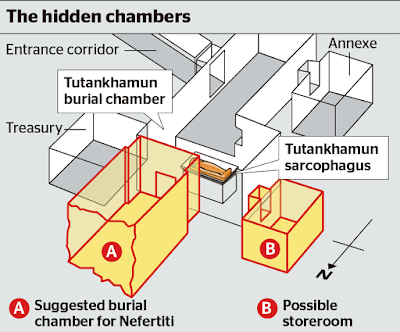TWO recognized Egyptian authorities say they believe it is possible that Nefertiti is buried in a secret chamber behind a hidden doorway in King Tutankhamun's tomb.
Egypt’s minister of antiquities, Mamdouh Eldamaty, told a news conference he will look into the theory put forth by renowned Egyptologist Nicholas Reeves. In a monograph, Reeves urged officials to at least look into the possibility without rejecting it outright.
"I agree with Nicholas Reeves," the Egyptian minister said.
The antiquities minister “had a long discussion” with Dr Reeves and invited him to Egypt.
The September meeting will see Dr Reeves present his case to an assembly of Egyptologists and archaeologists.
Unlike his previous dismissive comments, he now says Reeves' theory should be investigated, according to an Al Ahram report.
"In my opinion Reeves is one of the leading experts on the Valley of the Kings, with many publications on the subject to prove it," Hawass said of Reeves.
"Thus, if he says anything about the Valley, we all as Egyptologists have to respect him," Hawass added, "and I do respect him as a person, and I also respect his scholarship."
Dr Reeves’ evidence is circumstantial: He points to marks and depressions in the tomb’s walls, as revealed by new high-resolution photos, and combines these with prior evidence that the items in Tutankhamun’s grave were ‘recycled’ from a regal predecessor.
He also highlights anomalies in the paintings of the pharaoh in the burial chamber as indicating they are images of Nefertiti ‘doctored’ to look like the boy king.
It was a sufficiently strong argument to win the attention of Egypt’s government.
Our initial story in July (which you can READ HERE) made headlines around the world … and now the Egyptian government is taking Reeves's theory seriously and has promised to look into it further.
Writing in a paper published at ACADEMIA.EDU, Reeves bases his theory on new, high-definition color photography of painted scenes in Tutankhamun's burial chamber released in recent months online by Madrid-based art-replication specialists Factum Arte.
He believes he has discovered a secret doorway in a false wall within the tomb of King Tutankhamun. On the other side, he speculates, is the undisturbed burial of the tomb’s original owner - Queen Nefertiti, the wife of the "heretic" pharaoh, Akhenaten.
Since then the world’s media has been frothing at the prospect of the discovery of the century ... the tomb of one of Egypt’s most famous queens.
Archaeologists' reactions have ranged from cautiously hopeful to outright skepticism.
Leading the charge for the skeptics is Zahi Hawass, former head of Egypt’s Supreme Council of Antiquities.
He passionately states: "Reeves' study is a theory for fame and publicity and not based on archaeological or scientific evidences."
Less accusational, yet similarly doubtful, is Bristol University Egyptologist Aidan Dobson: "It's a long way from observing possible outlines of doors to the conclusion that one leads to the burial chamber of Nefertiti."
Reeves is the first to acknowledge that his is just a theory at this stage: "Each piece of evidence on its own is not conclusive, but put it all together and it's hard to avoid my conclusion.”
And if his theory is right, then it's “potentially the biggest archaeological discovery ever made.”
It shouldn't be too difficult for non-invasive radar to at least determine if there is a void behind the walls of Tutankhamun's burial chamber.
And if his theory is right, then it's “potentially the biggest archaeological discovery ever made.”
It shouldn't be too difficult for non-invasive radar to at least determine if there is a void behind the walls of Tutankhamun's burial chamber.
What they'll do next if there are indications that there IS something there is another matter. But that's certainly a good problem to have.






No comments:
Post a Comment